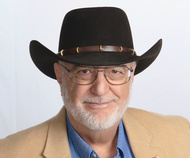
The Trees that Washed Away
Insurance Fraud Defeated by a Thorough Investigation
Barry Zalma
Posted on February 17, 2023 by Barry Zalma
Sorry I was Late with The Blog & the Newsletter
On 2/15/2023 I had a transcatheter aortic valve replacement (TAVR) procedure that replaced my poorly functioning Aortic Hart valve. I tolerated the procedure well although the recovery process took a day unmoving on my back. The Newsletter will be out soon but this blog post might give you some fun.
Insurance Fraud Defeated by a Thorough Investigation
A Fictionalized True Crime Story of Insurance Fraud from an Expert who explains why Insurance Fraud is a “Heads I Win, Tails You Lose” situation for Insurers. The stories help to Understand How Insurance Fraud in America is Costing Everyone who Buys Insurance Thousands of Dollars Every year and Why Insurance Fraud is Safer and More Profitable for the Perpetrators than any Other Crime.
Heads I Win, Tails You Lose
Northern San Diego County, California is avocado country. Trees grow everywhere. The heavy green fruit is a cash crop in an area that cannot resist guacamole.
The hills and valleys of California were once the bottom of the sea. Bedrock, at best, is sandstone. The soil is thin and porous. It is perfect soil for growing avocados because it drains well. Avocado farmers irrigate the roots to have enough, but not too much, water.
The farmers cannot, however, control the rain. If Southern California receives one of its rare, real, rainstorms, the soil turns to viscous slime. Gravity moves the hillsides into the valleys.
Property owners rebuild and replant regularly. Topographical maps become inaccurate after five to ten years. Mapping companies, to keep current, get aerial photographs as often as once every three years.
The insured was a successful businessman. He had made his fortune in manufacturing. The insured sold his business, and, wanting to be a gentleman rancher purchased a fifty-acre avocado ranch on a hillside in Northern San Diego County. He planted the hill with trees ranging in age from three to eight years. All bore the Haas variety of avocado. The insured irrigated with a drip irrigation system that provided the right amount of water to create the maximum amount of crop.
The insured knew nothing about avocado ranching. He intended to learn, on the job. He did not need the income from the crop to survive. He could live a life of luxury without any income from the ranch. He was a businessman. He understood that agriculture was a risky business. Risks he understood. The purchase of insurance can spread risks. He went to his corporate broker, told the broker of his concerns, and got a policy insuring against the loss of the trees. He had talked with his neighbors and knew, from his experience, that the risk faced by an avocado rancher was the loss of the trees from fire or an overabundance of rain.
The broker he used was the same broker who handled his manufacturing business. A major multinational brokerage firm with the purchasing power to insure anything their clients desired. The insured told his broker what he wanted. The insurer created a special policy by adding to the normal perils of fire, lightening, windstorm and hail, the peril of rain.
The Misrepresentations
At the time he bought the policy the insured knew that his ranch had lost, to mudslide, half its trees six years before. He also knew most of the trees fell down the hill five years before that. The insurer, in the application for insurance, only asked if the insured had incurred prior losses. Since he was a new owner of this property, he replied “New venture, no losses.”
The insurer issued the policy and for six months the insured enjoyed his leisure and supervised his small staff of farmhands. The insured harvested his first crop in February. The proceeds equaled his expenses. He was a happy man.
In March, the rains came. First, the gentle Southern California shower that dropped an inch of rain in forty-eight hours and turned the hillside green with new grass. Then, the remnants of typhoon Henry pulled up along the Southern California shore and stopped. Water dropped from the sky as if a giant tap had opened. Raindrops didn’t fall they cascaded out of the sky. The hillside became saturated within the first hour. The hill could absorb no more water. The rain continued. Rivers formed in every crease of every hill. The once stable hillside began to slide. Chunks of earth fifty feet wide and ten feet deep would pop off the hillsides and fall to the valleys below. Looking up through the rain, the insured saw his neat rows of trees begin to waver. Straight lines of trees danced, like an out of-control conga line, down the hillside. By the end of the day only two hundred of his ten thousand trees still stood on his hillside. The remainder were in the pasture of his downhill neighbor with their roots pointing to the sky.
When the rains stopped the insured called his broker to report a loss as a result of rain. The trees had a fair market value between $50 and $300 each. The insured could purchase them from commercial nurseries at various stages of development. The loss seemed a simple one to resolve. The insurer could not question, from the reports of the weather bureau, that the loss of the trees would not have occurred but for the unusual rain.
The Thorough Investigation
The insurer was faced with a massive loss. California law bound it to conduct a thorough investigation before rejecting the claim. The insurer learned that aerial photographs, taken regularly, were available. They purchased those photographs of the insured’s property going back thirty years before the loss. Surprised, the insurer found that in every ten-year span, portions of the hillside, and its trees, washed away. After each storm, the person owning the property replanted the trees. The insurer documented seven landslides destroying trees in the thirty years before the issuance of the policy.
Since the first insurance policy was written on a clay tablet in ancient Sumaria insurers and insureds have recognized that it is a business of the utmost good faith. For an insurance contract to be effective the insurer must be fully informed of the risk it is taking. If the insurer is deceived, whether intentionally or unintentionally, the contract will not survive. Good faith requires the insured to reveal everything he knows about the risk that would be material to the decision of the insurer to insure or not insure him. Failure to reveal material facts is concealment. When an insured conceals a material fact from the insurer, he is committing fraud in the inception of the policy. When an insured conceals or misrepresents a material fact in the presentation of a claim then he has committed fraud.
Arial Photos
The insurer confronted the insured with the aerial photographs. They asked if he had known about the earlier landslides. He admitted knowledge of one or two prior slides. He claimed he did not tell his insurer about the slides because they did not ask him nor did he feel it relevant to the application for insurance and the presentation of his claim for the slide that was the subject of his claim.
The claims man consulted with the underwriter. The underwriter said that he would never have written the policy had he known of the regularity with which the property suffered landslides. The only way he would insure the property was if the insured agreed to a specific exclusion for loss due to landslide, surface water or excessive rain.
The claims man sought advice of counsel. Counsel informed the insurer that the evidence it provided established a material concealment of fact. A concealment of material fact authorizes an insurer in California to rescind even if the concealment was innocent. If it wanted, the insurer could rescind the policy.
Counsel further advised that the insured would almost certainly sue. The suit would include a claim for breach of the covenant of good faith and fair dealing and punitive damages. The suit would be expensive to defend. Counsel further advised that jurors, because of their dislike for insurers, had a tendency to ignore a clear statement of the law given to them by the court. Jurors more frequently find the need to punish insurers.
The insurer’s adjuster had counted all of the trees on the insured’s land and obtained a number of all of the trees owned by the insured. The adjuster was surprised when he noted that the number of trees claimed destroyed exceeded, by a factor of three, the amount that existed at the time of the rain.
The insurer, with evidence that would support a rescission, decided to be practical rather than aggressively pursue its rights. Counsel met with the insured, showed that the number of trees counted from the aerial photographs showed less trees than those for which the claim was presented. Over a fine restaurant meal, the insured and counsel for the insurer settled the claim for the value of the tress counted in the aerial photographs less the value the remaining trees. Both considered the settlement to be favorable settlement. The underwriters for the insurer vowed to never insure trees on a hillside again.
This is not the type of fraud insurers’ normally face. There was no intent of the insured to defraud the insurer when he acquired the policy and he had no idea of the true number of trees since his purchase did not list a number of trees and he never did an inventory.
In fact, he did deceive the insurer but he had none of the malice required to prove fraud with regard to the acquisition of the policy. He did, however, overstate the number of trees he claimed lost.
Paying his claim was an economic decision. If justice could have been done, the insured would have been paid nothing. The insurer appeared to have wasted its assets because it knew it was less expensive to settle than to fight.
The insured and the insurer resolved the claim and the insurer agreed, in the settlement, that the insured wins on heads and the insurer loses on tails.
(c) 2023 Barry Zalma & ClaimSchool, Inc.
Subscribe and receive videos limited to subscribers of Excellence in Claims Handling at locals.com https://zalmaoninsurance.locals.com/subscribe.
Go to substack at substack.com/refer/barryzalma Consider subscribing to my publications at substack at substack.com/refer/barryzalma
Barry Zalma, Esq., CFE, now limits his practice to service as an insurance consultant specializing in insurance coverage, insurance claims handling, insurance bad faith and insurance fraud almost equally for insurers and policyholders. He practiced law in California for more than 44 years as an insurance coverage and claims handling lawyer and more than 54 years in the insurance business. He is available at http://www.zalma.com and [email protected]
Write to Mr. Zalma at [email protected]; http://www.zalma.com; http://zalma.com/blog; daily articles are published at
Zalma on Insurance
Insurance, insurance claims, insurance law, and insurance fraud .
By Barry Zalma
Go to the podcast Zalma On Insurance at https://anchor.fm/barry-zalma; Follow Mr. Zalma on Twitter at https://twitter.com/bzalma; Go to Barry Zalma videos at Rumble.com at https://rumble.com/c/c-262921; Go to Barry Zalma on YouTube- https://www.youtube.com/channel/UCysiZklEtxZsSF9DfC0Expg; Go to the Insurance Claims Library – https://zalma.com/blog/insurance-claims-library
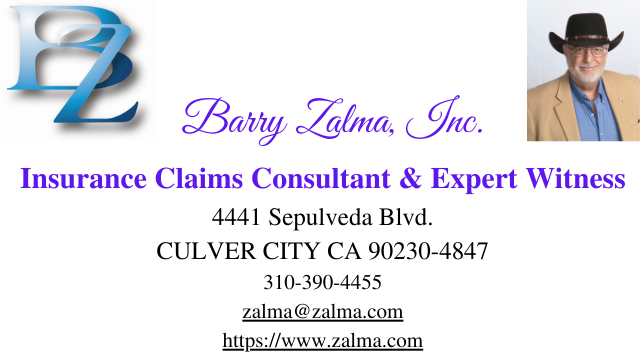
Post 5254
Read the full article at https://lnkd.in/gqva4sJq, see the video at https://lnkd.in/gR7AAuJR and at https://lnkd.in/gYfDxq_D, and at https://zalma.com/blog plus more than 5250 posts.
Help a Person Commit Insurance Fraud & Go to Jail
Guilty of Tampering With Evidence by Hiding it in Garage
In State Of Montana v. Lila Lynn Lord, 2025 MT 302, No. DA 24-0343, Supreme Court of Montana (December 30, 2025) Lila Lord (Lord) appealed her conviction for Tampering with Evidence following a jury trial in the Seventh Judicial District Court, Richland County. The case centered on a staged burglary in Sidney, Montana, orchestrated by Marie Chris Entzel with the intent to collect insurance proceeds to cover her son’s legal fees. Entzel recruited several individuals — including David Skaw, Lawrence Pohl, Laurie McGregor, and the defendant, Lila Lord — to assist in removing valuable items from her home, causing property damage and theft of items such as an enclosed trailer, boat and trailer, refrigerator, pistol, and television....
Posted on January 2, 2026 by Barry Zalma
ZIFL – Volume 30 Number 1
THE SOURCE FOR THE INSURANCE FRAUD PROFESSIONAL
See the video at https://rumble.com/v73nifg-zalmas-insurance-fraud-letter-january-2-2026.html and at https://youtu.be/vZC1e-_qwDg
Supreme Court of Louisiana Removes Judge
Judge Who Lied to Get Elected Cannot Serve
In In Re: Judge Tiffany Foxworth-Roberts, No. 2025-O-01127, Supreme Court of Louisiana (December 11, 2025) the Louisiana Supreme Court in an opinion by Chief Justice Weimer dealt with the recommendation of the Judiciary Commission of Louisiana (Commission) that Judge Tiffany Foxworth-Roberts be removed from office for:
1. making false and misleading statements regarding her judicial campaigns;
2. making false and misleading statements to police investigating the reported burglary of her car; and
3. withholding information and providing false, incomplete, or misleading information during the investigation by the Office of Special Counsel (OSC), as well as in the proceedings before the Commission....
Posted on January 2, 2026 by Barry Zalma
ZIFL – Volume 30 Number 1
THE SOURCE FOR THE INSURANCE FRAUD PROFESSIONAL
See the video at https://rumble.com/v73nifg-zalmas-insurance-fraud-letter-january-2-2026.html and at https://youtu.be/vZC1e-_qwDg
Supreme Court of Louisiana Removes Judge
Judge Who Lied to Get Elected Cannot Serve
In In Re: Judge Tiffany Foxworth-Roberts, No. 2025-O-01127, Supreme Court of Louisiana (December 11, 2025) the Louisiana Supreme Court in an opinion by Chief Justice Weimer dealt with the recommendation of the Judiciary Commission of Louisiana (Commission) that Judge Tiffany Foxworth-Roberts be removed from office for:
1. making false and misleading statements regarding her judicial campaigns;
2. making false and misleading statements to police investigating the reported burglary of her car; and
3. withholding information and providing false, incomplete, or misleading information during the investigation by the Office of Special Counsel (OSC), as well as in the proceedings before the Commission....
Court Must Follow Judicial Precedent
Post 5252
Read the full article at https://www.linkedin.com/pulse/sudden-opposite-gradual-barry-zalma-esq-cfe-h7qmc, see the video at and at and at https://zalma.com/blog plus more than 5250 posts.
Insurance Policy Interpretation Requires Application of the Judicial Construction Doctrine
In Montrose Chemical Corporation Of California v. The Superior Court Of Los Angeles County, Canadian Universal Insurance Company, Inc., et al., B335073, Court of Appeal, 337 Cal.Rptr.3d 222 (9/30/2025) the Court of Appeal refused to allow extrinsic evidence to interpret the word “sudden” in qualified pollution exclusions (QPEs) as including gradual but unexpected pollution. The court held that, under controlling California appellate precedent, the term “sudden” in these standard-form exclusions unambiguously includes a temporal element (abruptness) and cannot reasonably be construed to mean ...

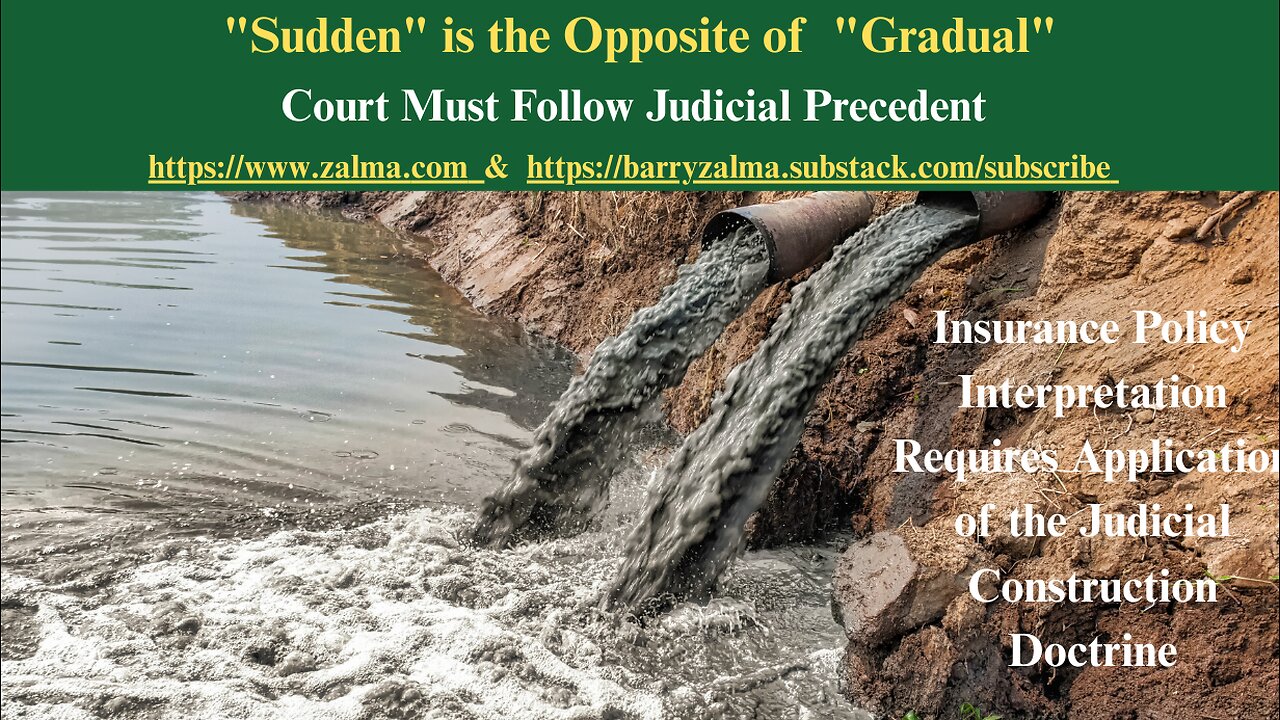
Lack of Jurisdiction Defeats Suit for Defamation
Post 5250
Posted on December 29, 2025 by Barry Zalma
See the video at and at
He Who Represents Himself in a Lawsuit has a Fool for a Client
In Pankaj Merchia v. United Healthcare Services, Inc., Civil Action No. 24-2700 (RC), United States District Court, District of Columbia (December 22, 2025)
FACTUAL BACKGROUND
Parties & Claims:
The plaintiff, Pankaj Merchia, is a physician, scientist, engineer, and entrepreneur, proceeding pro se. Merchia sued United Healthcare Services, Inc., a Minnesota-based medical insurance company, for defamation and related claims. The core allegation is that United Healthcare falsely accused Merchia of healthcare fraud, which led to his indictment and arrest in Massachusetts, causing reputational and business harm in the District of Columbia and nationwide.
Underlying Events:
The alleged defamation occurred when United ...
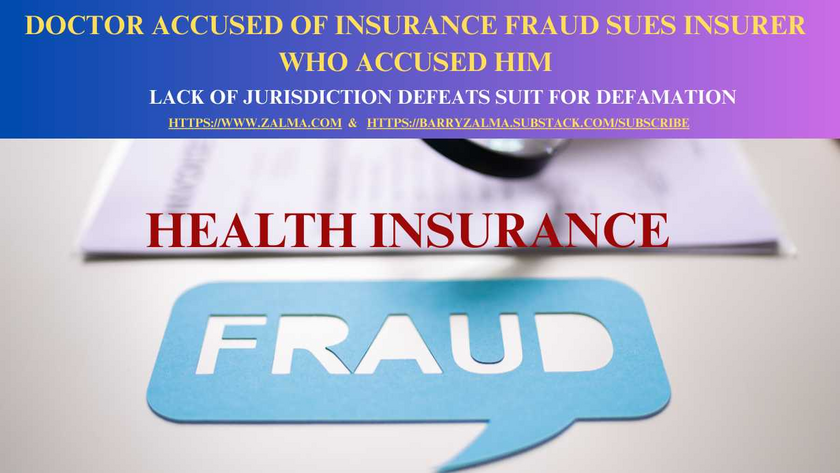
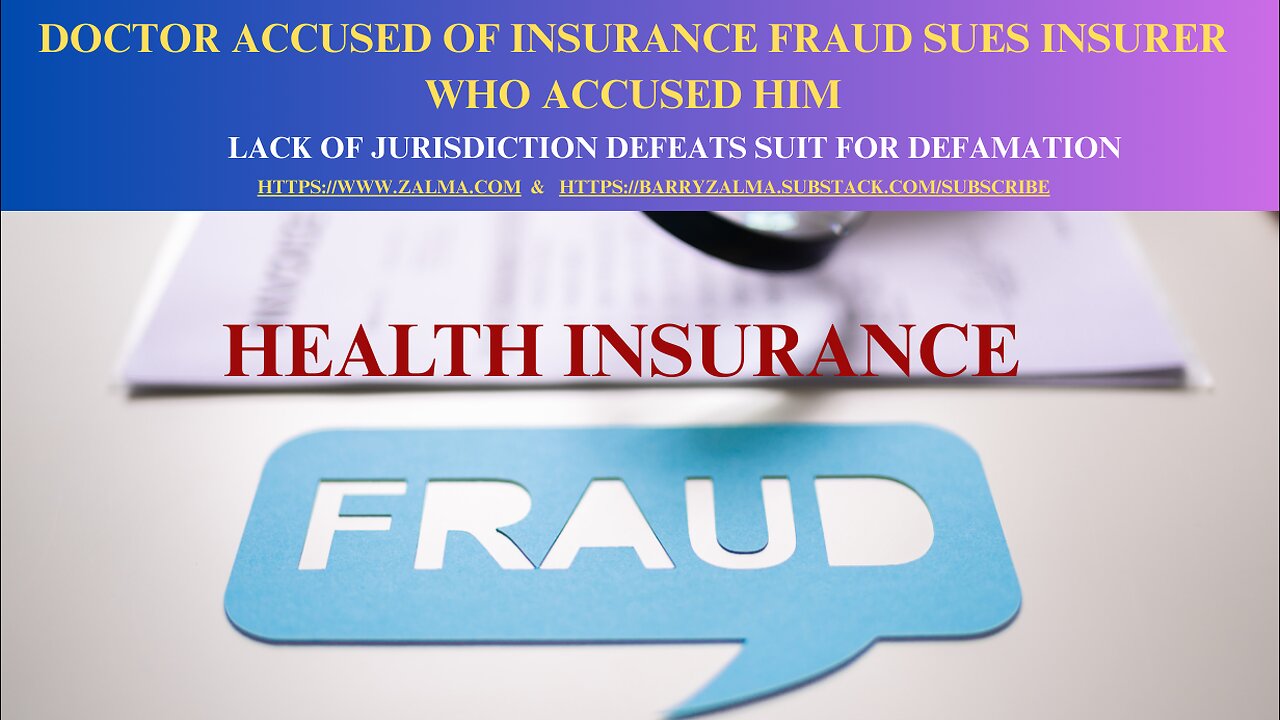
Zalma’s Insurance Fraud Letter
Read the full article at https://lnkd.in/dG829BF6; see the video at https://lnkd.in/dyCggZMZ and at https://lnkd.in/d6a9QdDd.
ZIFL Volume 29, Issue 24
Subscribe to the e-mail Version of ZIFL, it’s Free! https://visitor.r20.constantcontact.com/manage/optin?v=001Gb86hroKqEYVdo-PWnMUkcitKvwMc3HNWiyrn6jw8ERzpnmgU_oNjTrm1U1YGZ7_ay4AZ7_mCLQBKsXokYWFyD_Xo_zMFYUMovVTCgTAs7liC1eR4LsDBrk2zBNDMBPp7Bq0VeAA-SNvk6xgrgl8dNR0BjCMTm_gE7bAycDEHwRXFAoyVjSABkXPPaG2Jb3SEvkeZXRXPDs%3D
Zalma’s Insurance Fraud Letter (ZIFL) continues its 29th year of publication dedicated to those involved in reducing the effect of insurance fraud. ZIFL is published 24 times a year by ClaimSchool and is written by Barry Zalma. It is provided FREE to anyone who visits the site at http://zalma.com/zalmas-insurance-fraud-letter-2/
Zalma’s Insurance Fraud Letter
Merry Christmas & Happy Hannukah
Read the following Articles from the December 15, 2025 issue:
Read the full 19 page issue of ZIFL at ...












